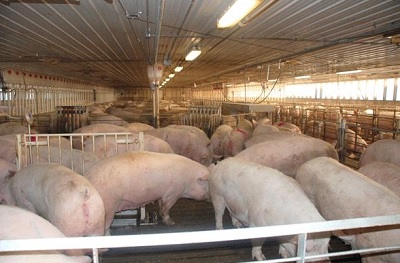Transition from individual gestation stalls to group pens. Interview with Lee Johnston
Published: June 2, 2015
Source : Analia Göttig, Community Manager, Engormix
Animal welfare concerns are having a significant impact on livestock production. A particular issue facing the swine industry is the transition from individual gestation stalls to group pens, which has become a hot topic. Engormix asked Professor Lee Johnston, extension swine specialist at the University of Minnesota, to throw some light on this situation.
In your opinion, what are the main concerns among pork producers to start housing pregnant sows in groups?
 Pork producers usually raise concerns anytime they are faced with implementing a system or management practice that is radically different than what they currently are doing. Adoption of group housing for pregnant sows is no different. The producers I know mostly are concerned about two things. First, reproductive performance of sows housed in groups. Can they maintain (or improve) reproductive performance compared to housing in individual stalls when the sow herd is moved to groups? Second, but just as important, is cost of the system. The costs include building costs because usually we need to offer more floor space per sow in group housing compared with individual stalls. So, producers must build larger sow barns to house their herd or reduce sow inventory. Neither is desirable. In addition, cost of the system also includes sow performance. If sow performance suffers in the move to groups, there is an added cost above building costs because the fixed cost of producing a weaned pig increases. So, sow performance has a direct influence on the profitability of the group housing system.
Pork producers usually raise concerns anytime they are faced with implementing a system or management practice that is radically different than what they currently are doing. Adoption of group housing for pregnant sows is no different. The producers I know mostly are concerned about two things. First, reproductive performance of sows housed in groups. Can they maintain (or improve) reproductive performance compared to housing in individual stalls when the sow herd is moved to groups? Second, but just as important, is cost of the system. The costs include building costs because usually we need to offer more floor space per sow in group housing compared with individual stalls. So, producers must build larger sow barns to house their herd or reduce sow inventory. Neither is desirable. In addition, cost of the system also includes sow performance. If sow performance suffers in the move to groups, there is an added cost above building costs because the fixed cost of producing a weaned pig increases. So, sow performance has a direct influence on the profitability of the group housing system. What factors should producers take into account to help them implement this system?
There are many factors that need to be considered but three rise to the top pretty quickly for me. First is the feeding system to be used. There are a wide range of options for feeding systems ranging from a very simple and inexpensive system that drops feed on the floor to a complex, expensive system, the Electronic Sow Feeder. Typically, gestating sows are limit-fed which sets the stage for competition and aggression among sows that want to consume more than their share of feed. The feeding system and the associated management of that feeding system will determine if producers can ensure each sow gets her daily allotment of feed. If a producer cannot ensure every sow gets her daily allotment of feed, sow performance will likely suffer. Producers need to spend a significant amount of effort selecting the feeding system they will use. Feeding systems can be classified into two groups: Competitive (floor feeding, drop feeding with shoulder stalls, drop feeding with full stalls) and Noncompetitive (Electronic sow feeders, or free-access, self-locking stalls) systems. Competitive systems tend to require less capital investment and rely on management practices to ensure sows receive their required amount of feed each day. On the other hand, Noncompetitive systems tend to be more expensive to purchase but provide opportunity for each sow to eat without disruption from penmates. Regardless of the feeding system used, producers will need to focus on effective management of the system. Effective management of the feeding system will take different forms depending on the system used.
The second important factor for successful management of a group housing system is having the proper people in place to care for the sows. Abilities of the stockperson can make or break a group housing system. Stockpeople must have a keen awareness of sow behavior and how sows are interacting with their penmates and pen environment. In a stalled system, a given sow is always in the same place each day. If a particular sow is sick and not eating, this is easily detected because her allotment of feed remains well after all other sows have consumed their allotment. If a sow requires special attention for ill-health or other conditions, the stockperson simply records the location of the sick sow and can return to that location multiple times to find the sow. However, in a group system, sows are mobile so a sick sow cannot necessarily be identified by remaining feed or her location. So, stockpeople must be more cognizant of sow behavior to identify sick sows, injured sows, and submissive sows that are not consuming sufficient feed.
The third important aspect of group sow housing is the proper mixing of sows. Once sows are mixed, they must establish their hierarchy within the group. They fight to establish this hierarchy and sometime will injure each other in the process. There has been much research conducted attempting to identify approaches to minimize this aggression at mixing. Producers need to be aware of the recommendations for reducing aggression and be willing to try new approaches to reduce aggression.
How is it possible to control aggression among pregnant sows when housed in groups? How can calm be promoted?
As mentioned above, aggression among sows is a normal part of sows housed in groups. There are two main categories of aggression in group housing: acute and chronic. Acute aggression is what occurs at the time of mixing and usually lasts for a relatively short period of time (less than 2 days). There are a variety of practices that can help mitigate, not eliminate, acute aggression. Practices such as: mixing sows after confirmation of pregnancy; providing “hides” for sows to duck around to end a fight; penning parity 1 sows with gilts rather than mature sows; mix sows in a larger pen; offer sows increased feed in the first couple days after mixing; include a vasectomized boar with the group at mixing; and introduce sows to the pen in groups of 4 to 6 females. Chronic aggression is the type of aggression that occurs regularly and is often associated with feeding. Because a limited amount of feed is offered to gestating sows, there will most always be some level of aggression among sows at feeding. However, noncompetitive feeding systems do a better job of controlling that aggression than do competitive feeding systems. If a competitive feeding system is used, be sure that all sows have ready access to feed for a sufficient time to allow them to consume their daily allotment.
There are no “silver bullets” that producers can use to eliminate aggression among sows in group housing systems. However, adopting a variety of practices will reduce the aggression to reasonable levels.
If a producer has decided to remodel his existing facilities, what would be the main requirements?
Remodeling existing sow barns with individual stalls to accommodate group housing is a challenge. Usually, the existing flooring, manure handling system, and feeding system are not what one would build if starting from scratch with a new building for group housing. So, compromises in design and barn layout often must be accepted in a remodeling effort. As mentioned above, selection of a feeding system and how that system will fit into the existing barn is of paramount importance.
Floor space allowance is also a very important factor. A typical gestation stall requires about 1.5 square meters. However, floor space allowance for group housed sows should be at least 1.8 square meters and can be as high as 2.2 square meters for larger sows. So, producers will be able to house fewer sows in their existing building compared with individual stalls. Group size is an important consideration. Group size is heavily dependent upon the feeding system selected. Electronic sow feeders will accommodate rather large group sizes (40 to 60 sows) while drop feeding on the floor probably works best with small group sizes of 6 to 8 sows.
Producers need to consider pen design when remodeling existing barns. Pigs prefer to lie along a wall if possible. So pens with more lineal wall space are preferred by sows. Large pens can be sectioned off into smaller “loafing” area with solid walls which provides two advantages. First, there is an increase in wall space compared with a simple square or rectangular pen. Second, the solid walls create hides that low-ranking sows can use as protection from more dominant sows. Typically, dominant sows will not pursue another sow much more than 2.5 meters when fighting. So, sows that are victims of aggression can use the solid walls to flee behind during a fight. Pens should have wide corridors or areas as much as possible. Providing a distance of 2 to 3 meters in corridors and pen areas will allow low-ranking sows to pass more dominant sows without a fight breaking out.

Why do some producers still believe crating pigs is the best option? Do you think a “best option” exists?
I have seen pigs raised in numerous different systems in many parts of the world. I have yet to see “the perfect” system for raising pigs or housing sows. It seems to me that every system has its strengths and weaknesses. Housing sows in groups can work very effectively and it can be a disaster. Likewise, there are farms that manage sows in individual stalls with great results and other farms where sow performance and welfare in stalls are not very good. In my mind, the producer and stockpeople working in the barn must decide what the priorities are for their housing system and work to ensure that the advantages of their chosen housing system are achieved and the weaknesses are minimized.
Source
Analia Göttig, Community Manager, EngormixRelated topics
Join to be able to comment.
Once you join Engormix, you will be able to participate in all content and forums.
* Required information
Would you like to discuss another topic? Create a new post to engage with experts in the community.
Create a post6 de julio de 2015
I love this kind of farm but I don't no where to start my father left me a big land in Ghana that I want to start pig farming I love pigs but I don't have any idea can some body help me here please email me pgyamfi81@yahoo.com
10 de junio de 2015
Look I worked in all types of ststems but I have to say that all our sows in Ireland and in Germany are loose and fed once a day and performance is better for us now than in stalls and all sows are let loose day 1 after service on to fully slatted systems on computer fed system. Brendan
9 de junio de 2015
Having managed all the main systems from individual crates to outdoor groups, both organic and commercial, the system I like the most is sow groups in deep litter systems, I achieved some of my best breeding and finishing results in deep litter barns, and achieved good welfare standards, not even having to dock tails.






